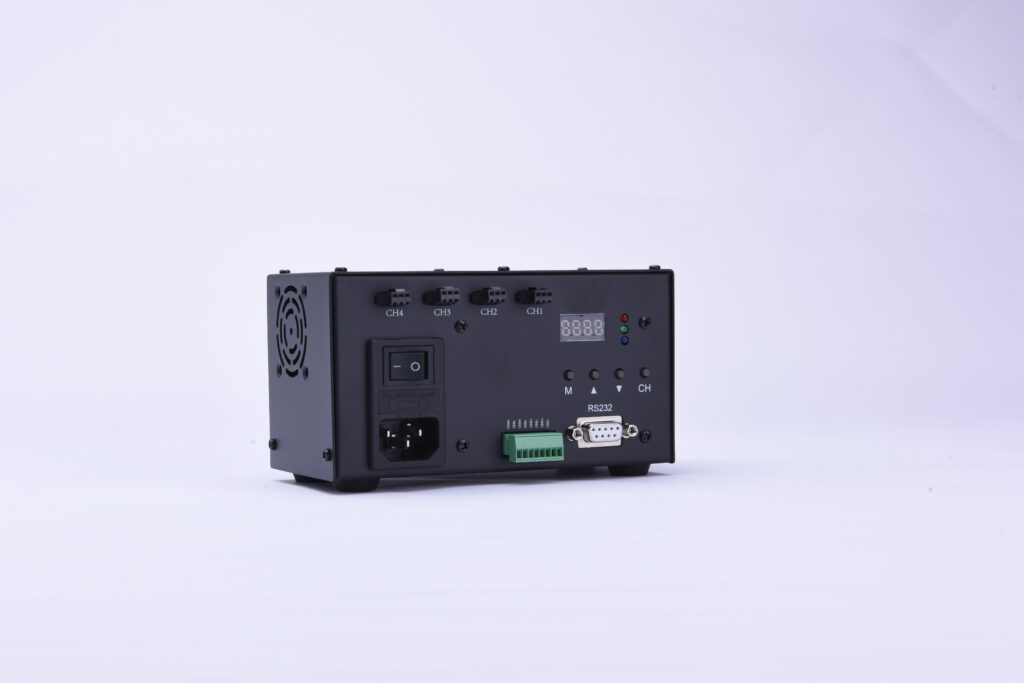In the machine vision system, the light source is one of the important factors that affect the image quality and detection effect. In order to ensure the stability and controllability of the light source, we need to use the light source controller to power and adjust the light source. So, what is a light source controller? What are its functions and advantages? This article will introduce from the following aspects:

Definition and principle of light source controller
The role and advantages of the light source controller
Classification and selection of light source controllers
Definition and principle of light source controller
The light source controller is a device used to supply power to the light source and control the brightness and lighting state of the light source. It can realize the strobe lighting of the light source through an external trigger signal, thereby prolonging the life of the light source and improving the image contrast.
The principle of the light source controller is to change the brightness of the light source by adjusting the output voltage or current, or to change the lighting time of the light source by changing the duty cycle of the output signal. Generally speaking, the larger the output voltage or current, the higher the brightness of the light source; the larger the duty cycle of the output signal, the longer the lighting time of the light source.
The role and advantages of the light source controller
The light source controller has the following functions and advantages in the machine vision system:
Ensure the stability of the light source. Due to the influence of factors such as ambient temperature and power grid fluctuations, the brightness of the light source may change, affecting image quality and detection results. Using the light source controller can keep the output voltage or current constant, so as to ensure the stability of the light source.
Improve the controllability of the light source. The light source controller can be used to adjust the brightness and lighting state of the light source according to different environments and goals, so as to adapt to different detection requirements. For example, on fast-moving or highly reflective targets, strobe lighting can be used to reduce motion blur or reflection interference.
Extend the life of the light source. The use of strobe lighting can reduce the working time and heat of the light source, thereby prolonging the life of the light source and saving energy consumption. For example, when only 10 images need to be captured in one second, a 10% duty cycle can be used to achieve strobe lighting, which is equivalent to shortening the working time of the light source by 90%.
Classification and selection of light source controllers
According to different control methods and adjustment methods, we can divide the light source controller into the following types:
Analog controller: use analog signal to control the light source, the brightness can be adjusted steplessly, the operation is simple, but the precision is low and it is easy to be interfered.
Digital controller: use digital signals to control the light source, the brightness can be adjusted in levels, the operation is complicated, but the precision is high and the stability is good.
Linear controller: use a linear circuit to control the light source, the output voltage or current is proportional to the input signal, the response speed is fast, but the efficiency is low and the heat generation is large.
PWM (Pulse Width Modulation) Controller: Use PWM signal to control the light source, the output voltage or current is proportional to the duty cycle of the input signal, with fast response, high efficiency and low heat generation.
According to different output power and number of channels, we can divide the light source controller into the following types:
Small power controller: The output power is below 10W, usually used to control small light sources such as point light sources and line light sources, with low price and small size.
Medium power controller: The output power is between 10W-100W, usually used to control medium-sized light sources such as ring light sources and parallel light sources. The price is moderate and the size is moderate.
High-power controller: The output power is above 100W, and it is usually used to control large-scale light sources such as large-area backlights and projection light sources. The price is relatively high and the volume is relatively large.
When choosing a light source controller, we need to consider the following aspects:
Types and parameters of light sources: Different types of light sources need to be matched with different types of controllers, for example, LED light sources require constant current or constant voltage controllers, and halogen lamps require constant voltage controllers. At the same time, pay attention to the voltage, current, power and other parameters of the light source, and choose a controller with an appropriate output range and power.
Lighting mode and effect: According to different lighting modes, choose a controller with or without an external trigger function. For example, a controller without a trigger function can be used for continuous lighting, and a controller with a trigger function is required for strobe lighting. At the same time, the requirements for lighting effects should also be considered, and an appropriate brightness adjustment method and precision controller should be selected. For example, a digital controller is required for high-precision detection, and an analog controller can be used for low-precision detection.
Control mode and convenience: According to different control modes, choose a controller with or without computer or manual control function. For example, a controller with computer control function can be used when remote or automatic control is required, and a controller with on-site or manual adjustment can be used Controller for manual control functions. At the same time, the convenience and ease of use of the controller should also be considered, and a controller with additional functions such as data protection, over-current protection, and multi-channel output should be selected.
Price and cost-effectiveness: According to different budgets and needs, choose a controller with an appropriate price and cost-effectiveness. Generally speaking, controllers with more functions, better performance, and better-known brands are more expensive, but may also have higher stability. safety and quality assurance. On the contrary, there may be lower prices and cost performance.
In short, when choosing a light source controller, we need to comprehensively consider various factors and make the best choice according to our actual situation and needs.

